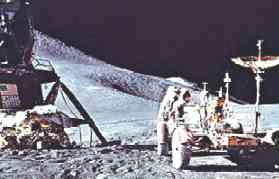Apollo 11: Man on the Moon
The summer of 1969 was busy for me. I had just finished my freshman year in college and my mind was elsewhere. I can just vaguely remember the first moon landing. To me it seemed like an inevitable event and it seemed to me too that we would soon have a colony on the moon. Only as I look back now, do I understand that that whole space program was a not about space exploration at all, but was a sideshow of the cold war with the Soviets. It was a "Small step for man", but was it really a "Giant leap for mankind"? |
 |
  |
The Apollo program was a moon-landing project executed by the United States National Aeronautics and Space Administration in the 1960s and 1970s. The Apollo program was announced in May 1961, but the choice among competing techniques for achieving a Moon landing and return was not resolved until considerable further study. The method ultimately employed was that of lunar-orbit rendezvous, by which a powerful launch vehicle (Saturn V) placed a 50-ton spacecraft in a lunar trajectory. Several launch vehicles, essentially large rockets, and accompanying spacecraft, were built. The Apollo spacecraft were supplied with a relatively slight rocket power of their own, capable of permitting them to brake on approach to the Moon and go into a lunar orbit. They also possessed the capability of releasing a component of the spacecraft, the Lunar Module (LM), carrying its own rocket power, to land persons on the Moon and bring them back to the lunar orbiting Apollo craft. The first manned Apollo flight was delayed by a tragic accident, a fire that broke out in the spacecraft during a launch rehearsal, killing three astronauts. On Oct. 11, 1968, following several unmanned Earth-orbit flights, Apollo 7 made a 163-orbit flight carrying a full crew of three astronauts. Apollo 8 carried out the first step of manned lunar exploration; from Earth orbit it was injected into a lunar trajectory, completed lunar orbit, and returned safely to Earth. Apollo 9 carried out a prolonged mission in Earth orbit to check out the Lunar Module. Apollo 10 journeyed to lunar orbit and tested the LM to within 9 1/2 miles (15 kilometres) of the Moon's surface. Apollo 11, in July 1969, climaxed the step-by-step procedure with a lunar landing; the astronaut Neil Armstrong became the first human to set foot on the Moon's surface. Apollo 13, launched in April 1970, suffered an accident caused by an explosion in an oxygen tank but returned safely to Earth. Remaining Apollo missions carried out extensive exploration of the lunar surface, collecting large numbers of samples of Moon rocks and installing many instruments for scientific research, such as the solar wind experiment, and the seismographic measurements of the lunar surface. Apollo 17, the final flight of the program, took place in December 1972. |